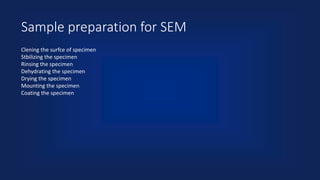
Specimen Preperation for Electron Microscope .pptx
- 1. Sample preparation for SEM Clening the surfce of specimen Stbilizing the specimen Rinsing the specimen Dehydrating the specimen Drying the specimen Mounting the specimen Coating the specimen
- 2. Cleaning the surface of the specimen proper cleaning of surface is essential to ensure the speciemen is free of dust, mud or soil. Stabilizing the specimen- Fixation Fixation is usually performed by incubating the sample in a solution of buffered chemical fixative, such as gluteraldehye, sometimes in combination with formaldehyde and other fixatives. Fixatives that are commonly used are Aldehydes, Osmium tetroxide, Tanic acid, Thiocarbohydrazide etc. These fixatives form covalent bonds with biological molecules to stabilize thiear structursl organization.
- 3. Rinsing the specimen Sample must be rinsed to remove excess fixatives. Dehydrating the specimen Water must be completely removed Air drying of the specimen causes collapse and shrinkage and therefore is fixed by a graded series of treatment with organic solvents like acetone or ethanol.
- 4. Drying the specimen The specimen must be completely dry since the specimen chamber is at high vacuum and sample would be destroyed at such a condition. Mounting of the specimen Specimen has to be mounted rigidly on the holder called specimen stub. Mounted using adhesives such as epoxy resin.
- 5. Coating the specimen • Mounted specimens are normally coated with a thin layer of heavy metal which serves as a source of secondary electron . • It also prevents high electron build up and increase conductivity. • Normally coated with thin layer (20nm- 30nm) of conductive metals lke gold, gold-palladium or platinum. • Non metals can be used by making them conductive with the help of a device called ‘’ Sputter coater’’. • Coated sample is kept inside specimen stub and image is finally formed on the computer monitor.
- 6. • This form of image processing is only in gray scale and therefore the images can only be viewed in black and white. • These images can be colourized through the use of editing softwares or graphic editors for realistic effects and clarifying the strucures.
- 7. Sample preparation- TEM • Cleaning the specimen • Primary fixation • Rinsing • Secondary fixation • Dehydration • Infiltration with resin • Sectioning • Staining
- 8. Cleaning the surface of the specimen • To remove unwanted deposits such as dust,slit and detritus . • Specimen is rinsed carefully, three times for 10 mins. in 0.1 M cacodylic buffer at room temperature. Fixation •Chemical processing of sample to stabilize its molecular organizations. •specimen is immersed in chemical preservatives called fixatives that denature and precipitates cellular macromolecules.
- 9. Commonly used fixatives :- • GLUTARALDEHYE : 5-Carbon with aldehyde group at each ends of the molecule. The aldehyde group reactes with amino group and cross links with the proteins to form an insoluble network. • OSMIUM : Heavy metal that react primarily with fatty acids leaading to the preservation of cellular membranes.
- 10. Rinsing- To remove the excess fixative, the sample is rinsed with 0.1M cacodylic acid buffer again for 2-3 times. Secondary fixation Specimen is post fixed with 1% Osmium tetroxide prepared in 0.1M cacodylic acid buffer for 1.5 hrs at room temperature (immersion fixation).
- 11. Dehydrating the Specimen • Specimen is dehydrated in a graded series of ethanol/ acetone. • Dehydrated in 50% ethanol for 5 mins, 70% ethanol for 10 mins, 80% for 10 mins, 90% ethanol for 15 mins and 99.9% ethanol for 20 mins twice. • This allows water in the sample to be slowly exchanged through liquids with lower surface tensions.
- 12. Infiltration • As ethanol is not miscible with plastic embedding medium, another intermediary solvent must be used. • It is actually an alochol substitution process. • Propyylene oxide is used for the process. • Sample is Immersed in propylene oxide twice for 20 mins at room temperature.
- 13. Embedding • Conventionally, Epoxy resins are used for embedding the specimen. • Epoxy resins are polyaryl ethers of glycerol with terminal epoxy group. • Unpolymerised liquid epoxy resins make the specimen hard like solid block.
- 14. Cutting • The embedded specimen is cut into ultra thin sections of 50-100 nm using a glass or diamond knife of special instrument called ultramicrotome. • These thin sections are taken on small copper discs called grids for support. • These sections are then stained with Uranium acetate followed by lead citrate to enchance contrast of many cellular structures. • Specimen mounted grid is then placed into specimen stage and the image is viewed either on a fluorescene screen or a photographic plate.
- 16. Introduction • Electron microscopes are very powerful tool in visualising biological samples. They allow us to view cells, tisues and small organisms clearly and specifically with great detai. • Biological samples are subjected to high energy electron beams and vacuum conditions and therefore cannot be viewed whilst alive . • They need to undergo certain preparations to withstand environments inside microscope.
- 17. Inside a Transmission Electron Microscope (TEM), electrons beams are of much higher energy to pass through the sample and out the other side. The temperature can rise upto 150℃ where the beam hits the sample and may cause damages to sample. This temperature is far too high for living cells to survive. Scanning electron microscope (SEM) uses a lower energy beam but it can still damage the sample. In TEM, images are viewed when electrons pass right through the sample and need the sample to be cut to very thin cross sections . Samples are coated with heavy metals to increase the level of contast . In SEM, samples aren’t cut to thin sections as it visualises the surface of 3-D objects . It is also coated with thin layr of metal to make it more conductive